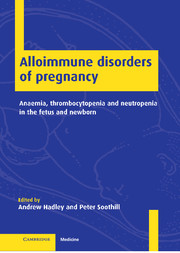 Alloimmune Disorders of Pregnancy
Alloimmune Disorders of Pregnancy Book contents
- Frontmatter
- Contents
- List of contributors
- Preface
- Foreword
- List of abbreviations
- 1 Pathophysiology of the alloimmune cytopenias
- 2 Blood group antibodies in haemolytic disease of the fetus and newborn
- 3 Basis and practice of screening for haemolytic disease of the fetus and newborn
- 4 Epidemiology and screening for alloimmune thrombocytopenia
- 5 Principles of antibody-mediated immune suppression and the prevention of maternal RhD alloimmunization
- 6 The clinical application of anti-D prophylaxis
- 7 Fetal genotyping
- 8 Laboratory assays to determine the severity of haemolytic disease of the fetus and newborn
- 9 Assessing the severity of haemolytic disease of the fetus and newborn: clinical aspects
- 10 Antenatal therapy for haemolytic disease of the fetus and newborn
- 11 Neonatal therapy for haemolytic disease of the newborn
- 12 The diagnosis of alloimmune thrombocytopenia
- 13 The immunological diagnosis of alloimmune neutropenia
- 14 Fetal and neonatal treatment of alloimmune thrombocytopenia
- Index
13 - The immunological diagnosis of alloimmune neutropenia
Published online by Cambridge University Press: 26 October 2009
- Frontmatter
- Contents
- List of contributors
- Preface
- Foreword
- List of abbreviations
- 1 Pathophysiology of the alloimmune cytopenias
- 2 Blood group antibodies in haemolytic disease of the fetus and newborn
- 3 Basis and practice of screening for haemolytic disease of the fetus and newborn
- 4 Epidemiology and screening for alloimmune thrombocytopenia
- 5 Principles of antibody-mediated immune suppression and the prevention of maternal RhD alloimmunization
- 6 The clinical application of anti-D prophylaxis
- 7 Fetal genotyping
- 8 Laboratory assays to determine the severity of haemolytic disease of the fetus and newborn
- 9 Assessing the severity of haemolytic disease of the fetus and newborn: clinical aspects
- 10 Antenatal therapy for haemolytic disease of the fetus and newborn
- 11 Neonatal therapy for haemolytic disease of the newborn
- 12 The diagnosis of alloimmune thrombocytopenia
- 13 The immunological diagnosis of alloimmune neutropenia
- 14 Fetal and neonatal treatment of alloimmune thrombocytopenia
- Index
Summary
Introduction
Alloimmune neutropenia is caused by the placental transfer of maternal antibodies which recognize neutrophil antigens inherited by the fetus from the father. Alloimmune neutropenia is characterized by a severe but transient neutropenia and is the neutrophil equivalent of haemolytic disease of the fetus and newborn and alloimmune thrombocytopenia. Neutrophils have a fundamental role in innate immunity and the inflammatory response, so neutropenic patients often present with local or systemic infections. The diagnosis of alloimmune neutropenia is dependent on demonstrating the presence of maternal antibodies which react with the infant's neutrophils. The target antigens are only expressed on mature polymorphonuclear neutrophils and these have been shown to be controlled by a number of different genetic loci.
Pathophysiology and clinical history
Immunogenicity of fetal neutrophils
The reported incidence of immunization against neutrophil alloantigens during pregnancy varies from 0.1% to 20%. Estimates of the incidence of alloimmune neutropenia are considerably lower, at less than 0.1% and 0.2%, for the German and US populations, respectively. The relatively low numbers of circulating neutrophils compared with red cells and platelets implies that maternal alloimmunization against fetal neutrophil-specific antigens resulting from fetomaternal haemorrhage might be infrequent. However, it is possible that significant numbers of granulocytes reach the maternal circulation by active migration through tissues in a process known as diapedesis.
Clinical manifestations and haematological findings
Alloimmune neutropenia is a rare clinical condition with a number of characteristic features.
- Type
- Chapter
- Information
- Alloimmune Disorders of PregnancyAnaemia, Thrombocytopenia and Neutropenia in the Fetus and Newborn, pp. 235 - 252Publisher: Cambridge University PressPrint publication year: 2001
